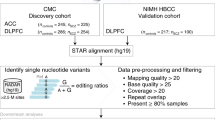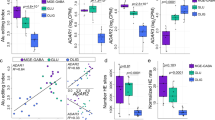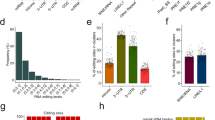Abstract
Adenosine-to-inosine (A-to-I) RNA editing is a neurodevelopmentally regulated epigenetic modification shown to modulate complex behavior in animals. Little is known about human A-to-I editing, but it is thought to constitute one of many molecular mechanisms connecting environmental stimuli and behavioral outputs. Thus, comprehensive exploration of A-to-I RNA editing in human brains may shed light on gene–environment interactions underlying complex behavior in health and disease. Synaptic function is a main target of A-to-I editing, which can selectively recode key amino acids in synaptic genes, directly altering synaptic strength and duration in response to environmental signals. Here, we performed a high-resolution survey of synaptic A-to-I RNA editing in a human population, and examined how it varies in autism, a neurodevelopmental disorder in which synaptic abnormalities are a common finding. Using ultra-deep (>1000 × ) sequencing, we quantified the levels of A-to-I editing of 10 synaptic genes in postmortem cerebella from 14 neurotypical and 11 autistic individuals. A high dynamic range of editing levels was detected across individuals and editing sites, from 99.6% to below detection limits. In most sites, the extreme ends of the population editing distributions were individuals with autism. Editing was correlated with isoform usage, clusters of correlated sites were identified, and differential editing patterns examined. Finally, a dysfunctional form of the editing enzyme adenosine deaminase acting on RNA B1 was found more commonly in postmortem cerebella from individuals with autism. These results provide a population-level, high-resolution view of A-to-I RNA editing in human cerebella and suggest that A-to-I editing of synaptic genes may be informative for assessing the epigenetic risk for autism.
This is a preview of subscription content, access via your institution
Access options
Subscribe to this journal
Receive 12 print issues and online access
$259.00 per year
only $21.58 per issue
Buy this article
- Purchase on Springer Link
- Instant access to full article PDF
Prices may be subject to local taxes which are calculated during checkout





Similar content being viewed by others
References
Jepson JE, Savva YA, Yokose C, Sugden AU, Sahin A, Reenan RA . Engineered alterations in RNA editing modulate complex behavior in Drosophila: regulatory diversity of adenosine deaminase acting on RNA (ADAR) targets. J Biol Chem 2011; 286: 8325–8337.
Mombereau C, Kawahara Y, Gundersen BB, Nishikura K, Blendy JA . Functional relevance of serotonin 2C receptor mRNA editing in antidepressant- and anxiety-like behaviors. Neuropharmacology 2010; 59: 468–473.
Tonkin LA, Saccomanno L, Morse DP, Brodigan T, Krause M, Bass BL . RNA editing by ADARs is important for normal behavior in Caenorhabditis elegans. EMBO J 2002; 21: 6025–6035.
Maas S . Gene regulation through RNA editing. Discov Med 2010; 10: 379–386.
Mattick JS . RNA as the substrate for epigenome-environment interactions: rNA guidance of epigenetic processes and the expansion of RNA editing in animals underpins development, phenotypic plasticity, learning, and cognition. Bioessays 2010; 32: 548–552.
Nishikura K . Functions and regulation of RNA editing by ADAR deaminases. Annu Rev Biochem 2010; 79: 321–349.
Lomeli H, Mosbacher J, Melcher T, Hoger T, Geiger JR, Kuner T et al. Control of kinetic properties of AMPA receptor channels by nuclear RNA editing. Science 1994; 266: 1709–1713.
Kohler M, Burnashev N, Sakmann B, Seeburg PH . Determinants of Ca2+ permeability in both TM1 and TM2 of high affinity kainate receptor channels: diversity by RNA editing. Neuron 1993; 10: 491–500.
Rula EY, Lagrange AH, Jacobs MM, Hu N, Macdonald RL, Emeson RB . Developmental modulation of GABA(A) receptor function by RNA editing. J Neurosci 2008; 28: 6196–6201.
Feldmeyer D, Kask K, Brusa R, Kornau HC, Kolhekar R, Rozov A et al. Neurological dysfunctions in mice expressing different levels of the Q/R site-unedited AMPAR subunit GluR-B. Nat Neurosci 1999; 2: 57–64.
Burns CM, Chu H, Rueter SM, Hutchinson LK, Canton H, Sanders-Bush E et al. Regulation of serotonin-2C receptor G-protein coupling by RNA editing. Nature 1997; 387: 303–308.
Kawahara Y, Zinshteyn B, Sethupathy P, Iizasa H, Hatzigeorgiou AG, Nishikura K . Redirection of silencing targets by adenosine-to-inosine editing of miRNAs. Science 2007; 315: 1137–1140.
Kawahara Y, Zinshteyn B, Chendrimada TP, Shiekhattar R, Nishikura K . RNA editing of the microRNA-151 precursor blocks cleavage by the Dicer-TRBP complex. EMBO Rep 2007; 8: 763–769.
Yang W, Chendrimada TP, Wang Q, Higuchi M, Seeburg PH, Shiekhattar R et al. Modulation of microRNA processing and expression through RNA editing by ADAR deaminases. Nat Struct Mol Biol 2006; 13: 13–21.
Borchert GM, Gilmore BL, Spengler RM, Xing Y, Lanier W, Bhattacharya D et al. Adenosine deamination in human transcripts generates novel microRNA binding sites. Hum Mol Genet 2009; 18: 4801–4807.
Mehler MF, Mattick JS . Noncoding RNAs and RNA editing in brain development, functional diversification, and neurological disease. Physiol Rev 2007; 87: 799–823.
Li JB, Levanon EY, Yoon JK, Aach J, Xie B, Leproust E et al. Genome-wide identification of human RNA editing sites by parallel DNA capturing and sequencing. Science 2009; 324: 1210–1213.
Mattick JS, Mehler MF . RNA editing, DNA recoding and the evolution of human cognition. Trends Neurosci 2008; 31: 227–233.
Garrett S, Rosenthal JJ . RNA editing underlies temperature adaptation in K+ channels from polar octopuses. Science 2012; 335: 848–851.
Macbeth MR, Schubert HL, Vandemark AP, Lingam AT, Hill CP, Bass BL . Inositol hexakisphosphate is bound in the ADAR2 core and required for RNA editing. Science 2005; 309: 1534–1539.
Patterson JB, Samuel CE . Expression and regulation by interferon of a double-stranded-RNA-specific adenosine deaminase from human cells: evidence for two forms of the deaminase. Mol Cell Biol 1995; 15: 5376–5388.
Englander MT, Dulawa SC, Bhansali P, Schmauss C . How stress and fluoxetine modulate serotonin 2C receptor pre-mRNA editing. J Neurosci 2005; 25: 648–651.
Wahlstedt H, Daniel C, Enstero M, Ohman M . Large-scale mRNA sequencing determines global regulation of RNA editing during brain development. Genome Res 2009; 19: 978–986.
Wulff BE, Nishikura K . Substitutional A-to-I RNA editing. WIREs RNA 2010; 1: 90–101.
Jepson JE, Reenan RA . RNA editing in regulating gene expression in the brain. Biochim Biophys Acta 2008; 1779: 459–470.
Peng Z, Cheng Y, Tan BC, Kang L, Tian Z, Zhu Y et al. Comprehensive analysis of RNA-Seq data reveals extensive RNA editing in a human transcriptome. Nat Biotechnol 2012; 30: 253–260.
Athanasiadis A, Rich A, Maas S . Widespread A-to-I RNA editing of Alu-containing mRNAs in the human transcriptome. PLoS Biol 2004; 2: e391.
Paz-Yaacov N, Levanon EY, Nevo E, Kinar Y, Harmelin A, Jacob-Hirsch J et al. Adenosine-to-inosine RNA editing shapes transcriptome diversity in primates. Proc Natl Acad Sci USA 2010; 107: 12174–12179.
Toro R, Konyukh M, Delorme R, Leblond C, Chaste P, Fauchereau F et al. Key role for gene dosage and synaptic homeostasis in autism spectrum disorders. Trends Genet 2010; 26: 363–372.
Voineagu I, Wang X, Johnston P, Lowe JK, Tian Y, Horvath S et al. Transcriptomic analysis of autistic brain reveals convergent molecular pathology. Nature 2011; 474: 380–384.
Bourgeron T . A synaptic trek to autism. Curr Opin Neurobiol 2009; 19: 231–234.
Gilman SR, Iossifov I, Levy D, Ronemus M, Wigler M, Vitkup D . Rare de novo variants associated with autism implicate a large functional network of genes involved in formation and function of synapses. Neuron 2011; 70: 898–907.
Anney RJ, Kenny EM, O’Dushlaine C, Yaspan BL, Parkhomenka E, Buxbaum JD et al. Gene-ontology enrichment analysis in two independent family-based samples highlights biologically plausible processes for autism spectrum disorders. Eur J Hum Genet 2011; 19: 1082–1089.
Pinto D, Pagnamenta AT, Klei L, Anney R, Merico D, Regan R et al. Functional impact of global rare copy number variation in autism spectrum disorders. Nature 2010; 466: 368–372.
Sakai Y, Shaw CA, Dawson BC, Dugas DV, Al-Mohtaseb Z, Hill DE et al. Protein interactome reveals converging molecular pathways among autism disorders. Sci Transl Med 2011; 3: 86ra49.
Hallmayer J, Cleveland S, Torres A, Phillips J, Cohen B, Torigoe T et al. Genetic heritability and shared environmental factors among twin pairs with autism. Arch Gen Psychiatry 2011; 68: 1095–1102.
Ronald A, Hoekstra RA . Autism spectrum disorders and autistic traits: a decade of new twin studies. Am J Med Genet B Neuropsychiatr Genet 2011; 156B: 255–274.
Grafodatskaya D, Chung B, Szatmari P, Weksberg R . Autism spectrum disorders and epigenetics. J Am Acad Child Adolesc Psychiatry 2010; 49: 794–809.
Singh M, Zimmerman MB, Beltz TG, Johnson AK . Affect-related behaviors in mice misexpressing the RNA editing enzyme ADAR2. Physiol Behav 2009; 97: 446–454.
Jepson JE, Savva YA, Yokose C, Sugden AU, Sahin A, Reenan RA . Engineered alterations in RNA editing modulate complex behavior in Drosophila: regulatory diversity of adenosine deaminase acting on RNA (ADAR) targets. J Biol Chem 2011; 286: 8325–8337.
Morabito MV, Abbas AI, Hood JL, Kesterson RA, Jacobs MM, Kump DS et al. Mice with altered serotonin 2C receptor RNA editing display characteristics of Prader-Willi syndrome. Neurobiol Dis 2010; 39: 169–180.
Canitano R . Epilepsy in autism spectrum disorders. Eur Child Adolesc Psychiatry 2007; 16: 61–66.
Veltman MW, Craig EE, Bolton PF . Autism spectrum disorders in Prader-Willi and Angelman syndromes: a systematic review. Psychiatr Genet 2005; 15: 243–254.
Nakatani J, Tamada K, Hatanaka F, Ise S, Ohta H, Inoue K et al. Abnormal behavior in a chromosome-engineered mouse model for human 15q11–13 duplication seen in autism. Cell 2009; 137: 1235–1246.
Daniels JL, Forssen U, Hultman CM, Cnattingius S, Savitz DA, Feychting M et al. Parental psychiatric disorders associated with autism spectrum disorders in the offspring. Pediatrics 2008; 121: e1357–e1362.
Sodhi MS, Burnet PW, Makoff AJ, Kerwin RW, Harrison PJ . RNA editing of the 5-HT(2C) receptor is reduced in schizophrenia. Mol Psychiatry 2001; 6: 373–379.
Gurevich I, Tamir H, Arango V, Dwork AJ, Mann JJ, Schmauss C . Altered editing of serotonin 2C receptor pre-mRNA in the prefrontal cortex of depressed suicide victims. Neuron 2002; 34: 349–356.
Hagerman R, Hoem G, Hagerman P . Fragile X and autism: Intertwined at the molecular level leading to targeted treatments. Mol Autism 2010; 1: 12.
Bhogal B, Jepson JE, Savva YA, Pepper AS, Reenan RA, Jongens TA . Modulation of dADAR-dependent RNA editing by the Drosophila fragile X mental retardation protein. Nat Neurosci 2011; 14: 1517–1524.
Peca J, Ting J, Feng G . SnapShot: autism and the synapse. Cell 2011; 147: 706.
Stephenson DT, O’Neill SM, Narayan S, Tiwari A, Arnold E, Samaroo HD et al. Histopathologic characterization of the BTBR mouse model of autistic-like behavior reveals selective changes in neurodevelopmental proteins and adult hippocampal neurogenesis. Mol Autism 2011; 2: 7.
Wang X, McCoy PA, Rodriguiz RM, Pan Y, Je HS, Roberts AC et al. Synaptic dysfunction and abnormal behaviors in mice lacking major isoforms of Shank3. Hum Mol Genet 2011; 20: 3093–3108.
Gai X, Xie HM, Perin JC, Takahashi N, Murphy K, Wenocur AS et al. Rare structural variation of synapse and neurotransmission genes in autism. Mol Psychiatry 2012; 17: 402–411.
Farra N, Zhang WB, Pasceri P, Eubanks JH, Salter MW, Ellis J . Rett syndrome induced pluripotent stem cell-derived neurons reveal novel neurophysiological alterations. Mol Psychiatry, advance online publication, 10 January 2012; doi:10.1038/mp.2011.180.
Durrenberger PF, Fernando S, Kashefi SN, Ferrer I, Hauw JJ, Seilhean D et al. Effects of antemortem and postmortem variables on human brain mRNA quality: a BrainNet Europe study. J Neuropathol Exp Neurol 2010; 69: 70–81.
Margulies M, Egholm M, Altman WE, Attiya S, Bader JS, Bemben LA et al. Genome sequencing in microfabricated high-density picolitre reactors. Nature 2005; 437: 376–380.
Shamir R, Maron-Katz A, Tanay A, Linhart C, Steinfeld I, Sharan R et al. EXPANDER—an integrative program suite for microarray data analysis. BMC Bioinform 2005; 6: 232.
Benjamini Y, Hochberg Y . Controlling the false discovery rate: a practical and powerful approach to multiple testing. J Royal Stat Soc 1995; 57: 125–133.
Belcher SM, Howe JR . Characterization of RNA editing of the glutamate-receptor subunits GluR5 and GluR6 in granule cells during cerebellar development. Brain Res Mol Brain Res 1997; 52: 130–138.
Bhalla T, Rosenthal JJ, Holmgren M, Reenan R . Control of human potassium channel inactivation by editing of a small mRNA hairpin. Nat Struct Mol Biol 2004; 11: 950–956.
Nishikura K . Editor meets silencer: crosstalk between RNA editing and RNA interference. Nat Rev Mol Cell Biol 2006; 7: 919–931.
Abrahams BS, Geschwind DH . Connecting genes to brain in the autism spectrum disorders. Arch Neurol 2010; 67: 395–399.
Mostofsky SH, Powell SK, Simmonds DJ, Goldberg MC, Caffo B, Pekar JJ . Decreased connectivity and cerebellar activity in autism during motor task performance. Brain 2009; 132 (Part 9): 2413–2425.
Palmen SJ, van Engeland H, Hof PR, Schmitz C . Neuropathological findings in autism. Brain 2004; 127 (Part 12): 2572–2583.
Higuchi M, Maas S, Single FN, Hartner J, Rozov A, Burnashev N et al. Point mutation in an AMPA receptor gene rescues lethality in mice deficient in the RNA-editing enzyme ADAR2. Nature 2000; 406: 78–81.
Abrahams BS, Geschwind DH . Advances in autism genetics: on the threshold of a new neurobiology. Nat Rev Genet 2008; 9: 341–355.
Rueter SM, Dawson TR, Emeson RB . Regulation of alternative splicing by RNA editing. Nature 1999; 399: 75–80.
Kawahara Y, Ito K, Ito M, Tsuji S, Kwak S . Novel splice variants of human ADAR2 mRNA: skipping of the exon encoding the dsRNA-binding domains, and multiple C-terminal splice sites. Gene 2005; 363: 193–201.
Levanon EY, Hallegger M, Kinar Y, Shemesh R, Djinovic-Carugo K, Rechavi G et al. Evolutionarily conserved human targets of adenosine to inosine RNA editing. Nucleic Acids Res 2005; 33: 1162–1168.
Dracheva S, Lyddon R, Barley K, Marcus SM, Hurd YL, Byne WM . Editing of serotonin 2C receptor mRNA in the prefrontal cortex characterizes high-novelty locomotor response behavioral trait. Neuropsychopharmacology 2009; 34: 2237–2251.
Du Y, Stasko M, Costa AC, Davisson MT, Gardiner KJ . Editing of the serotonin 2C receptor pre-mRNA: Effects of the Morris Water Maze. Gene 2007; 391: 186–197.
Auerbach BD, Osterweil EK, Bear MF . Mutations causing syndromic autism define an axis of synaptic pathophysiology. Nature 2011; 480: 63–68.
Rossignol DA, Frye RE . Mitochondrial dysfunction in autism spectrum disorders: a systematic review and meta-analysis. Mol Psychiatry 2012; 17: 290–314.
Garbett K, Ebert PJ, Mitchell A, Lintas C, Manzi B, Mirnics K et al. Immune transcriptome alterations in the temporal cortex of subjects with autism. Neurobiol Dis 2008; 30: 303–311.
Lainhart JE, Lange N . Increased neuron number and head size in autism. JAMA 2011; 306: 2031–2032.
Acknowledgements
We thank Oliver St Lawrence, Jamie Jett, Benjamin Boese and Tim Harkins at 454, our wonderful lab mates, Professor David Bartel, Thutrang Nguyen, Eran Mick and Elena Helman for their tremendous help. Human tissue was obtained from the National Institute of Child Health and Human Development Brain and Tissue Bank for Developmental Disorders at the University of Maryland, Baltimore, MD, USA contract HHSN275200900011C, re. no. N01-HD-9-0011, and from The Harvard Brain Tissue Resource Center, through the Autism Tissue Program. The Harvard Brain Tissue Resource Center is supported by grant MH068855. The Molecular Genetics Core Facility at Children’s Hospital Boston Intellectual and Developmental Disabilities Research Center (IDDRC) is supported by grant NIH-P30-HD18655. This study was generously supported by the Nancy Lurie Marks Family Foundation, The Roche Applied Science Sequencing Grant Program, Autism Speaks, Simons Foundation and the NIH Grant 1R01MH085143-01.
Author information
Authors and Affiliations
Corresponding authors
Ethics declarations
Competing interests
The authors declare no conflict of interest.
Additional information
Supplementary Information accompanies the paper on the Molecular Psychiatry website
Supplementary information
Rights and permissions
About this article
Cite this article
Eran, A., Li, J., Vatalaro, K. et al. Comparative RNA editing in autistic and neurotypical cerebella. Mol Psychiatry 18, 1041–1048 (2013). https://doi.org/10.1038/mp.2012.118
Received:
Revised:
Accepted:
Published:
Issue Date:
DOI: https://doi.org/10.1038/mp.2012.118
Keywords
This article is cited by
-
Automated Isoform Diversity Detector (AIDD): a pipeline for investigating transcriptome diversity of RNA-seq data
BMC Bioinformatics (2020)
-
Widespread RNA editing dysregulation in brains from autistic individuals
Nature Neuroscience (2019)
-
A-to-I RNA editing — immune protector and transcriptome diversifier
Nature Reviews Genetics (2018)
-
Bio-collections in autism research
Molecular Autism (2017)
-
A-to-I editing of coding and non-coding RNAs by ADARs
Nature Reviews Molecular Cell Biology (2016)



